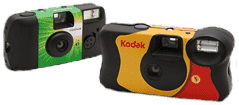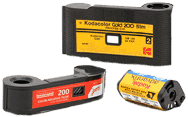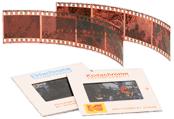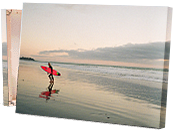One of the best ways to get started in film photography involves a quick trip to The Darkroom – or any other film lab or camera store. The best bit is that you don’t need to walk in with a fist full of dollars in anticipation of financial pain. You can start your film photography journey with a simple single-use or disposable camera.
You don’t need to head to the Leica store prepared to take out a second mortgage. Nor do you have to spend time learning a complex antique SLR or retro rangefinder. A single-use 35mm film camera is the ideal way to get your toes in the water – well before you dive in. Disposable cameras are one of the most overlooked tools in a photographer’s kit. Even those that shoot with digital SLRs or mirrorless cameras can learn a lot from picking up a disposable film camera or two.
Shooting with film is a whole new world when compared to the automated control of digital formats. And while a single-use camera is the simplest and purest of film cameras, there’s still a lot to learn. While Kodak and Fujifilm have long-held market dominance, there are many more options for disposable 35mm film cameras than you would believe.
Getting To Know Single Use Cameras
A disposable film camera can be a joyful and frustrating experience all at the same time. The joy comes from using a simple yet effective mechanism to shoot 35mm film stock. While the film options are limited to what’s already pre-installed in the plastic-fantastic body, there’s a charm to shooting with what you have. The frustration comes from the limited control for more experienced photographers.
It seems that disposable cameras have a consistent build and set of features aside from the waterproof versions. Here’s a list of standard features:
- A plastic lens that is NOT impervious to scratches.
- Most lenses are wide, averaging around 28mm with an aperture of around f/8.
- Shutter speed is usually about 1/125.
- Plastic optical viewfinder.
- Film position window – again plastic.
- Built-in flash powered by an internal battery and triggered by a separate button or slider.
- Pocketable lightweight design.
- Most have 27 exposures and 400 ISO speed.
- Waterproof cameras don’t have a flash but have a watertight housing and wrist strap.
Tips For Shooting With a Single Use Camera
While disposable cameras appear to be a very simple-to-use film camera, there’s a couple of things to keep in mind when shooting with one. By far, the most important tip is to slow down, stand still, and don’t shake the camera. You’re not shooting with a DSLR or smartphone here!
Lighting and ISO Speed
Most single-use cameras use a film with an ISO 400 speed film. It is the most common film as it’s ideal for well-lit situations. And if you are in a low-light setting, the flash use can help balance your exposure. Some disposable cameras are available with an ISO 800 speed film. As a result, these suit lower light scenarios where you don’t want to use a flash.
The Kodak Fun Saver features an 800 ISO film perfect in low light situations and still usable in daylight conditions. Another use of the 800 ISO film is with the underwater single-use cameras by Fujifilm and Kodak. As there is no flash, the need for a faster speed film is essential when submerged. The deeper you go, the less light there is as the water filters light.
Always use the Flash
Unless you’re shooting toward reflective objects like windows and mirrors, use the Flash for best results… even in daylight. Exposures always come out sharp in settings with lots of light.
Composition
It is worth pointing out that single-use cameras are not precision engineered. As a result, you need to be a little ‘loose’ with how you compose your shots. While it is not a case of lining it up and hoping for the best, you need to be conscious of what’s in the frame. As these are mass-produced products, the alignment between the plastic optical viewfinder and the lens is not 100% accurate.
But for $10, what do you expect? The trick is to consider what you want to frame and not leave too much to chance. If you are concerned that subjects on the edge of the composition may be missed, take a step back. If shooting portraits, allow a little space between your subject’s face and the edge of the frame. You can always crop the scan of the image later.
The Best Uses Of Disposable Cameras
Single-use or disposable cameras are not just for those interested in testing the film photography waters. While they are great for students, teens, and people who don’t take photography seriously, many other use cases exist.
By far, the most common use of a single-use film camera is for taking holiday snaps. We have all found ourselves in a situation where we wished we had brought our camera from home. We tend to dash to the nearest drug or convenience store to make a ten-dollar purchase.
Beyond that, disposable cameras make a fun addition to a significant event such as a wedding or party. Wedding photographers and those planning events often buy single-use cameras in bulk. They place one of each of the guest tables or fill a big glass bowl with them at the bar. That way, guests have a fun activity that adds to the happy and fun vibe of the event – especially once the drinks start flowing. Plus, you can avoid hiring a photographer as your guests take all the shots.
Another great use of single-use cameras is for seasoned and experienced photographers to take on a photography challenge. If you are part of a landscape or street photography group, invite attendees to a photo challenge. Regardless of them usually using film or digital, set a disposable camera challenge. It’s a great way to change up the usual group meets and may lead to fresh inspiration.
Variety Is The Spice Of Life
Kodak and Fuji dominate the disposable camera market as they are the most recognized brand. Head into any drug store or corner supermarket, and you’ll spot the green Fujifilm branding or yellow Kodak ones. Plus, they tend to be the cheapest. However, there’s a growing list of big and small brands releasing their version of the humble single-use camera.
Lomography creates a brilliant range of film stock right down to the Babylon 13 ISO and Fantome 8 ISO. Lomo also provides a range of single-use cameras, including a Simple Use Colour and Black and White version. What’s more, they have a phenomenal single-use camera featuring the LomoChrome Purple 400 film.
Ilford has a long and exciting history in the film stock and photography paper world. They also produce a pair of disposable cameras with Ilford XP2 Black and WHite or HP5 Colour Negative films. Both films are highly acclaimed and popular choices for enthusiast film photographers requiring an everyday stock.
The last two options currently available are the same camera with a different cover sticker and film stock inside. The JCH or Japan Camera Hunter is named after the infamous street photographer and loaded with a role of his JCH Street Pan 400. The Rollei Inferno Ragazzi houses a roll of Rollei RPX 400 Black and White film.
As you can see, there’s a lot more to disposable cameras than meets the eye. Our team at The Darkroom loves these pick-up-and-play film cameras, and as a result, we stock them all. Plus, we offer fast, reliable, and quality developing and scanning of your film. If you need help choosing the right single-use camera for you, get in touch or drop by the store. Keep reading to see the full range in more detail.



 My Account
My Account










 Gift Cards
Gift Cards Film Index
Film Index FAQ
FAQ Desktop Framed Prints
Desktop Framed Prints